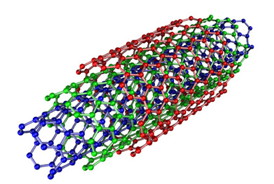Home > Press > Coating Nanotubes with Aluminum Oxide Lowers Risk of Lung Injury
 |
| Image of a multi-walled carbon nanotube. Image credit: Eric Wieser, via WikiMedia Commons. |
Abstract:
A new study from North Carolina State University and the National Institute of Environmental Health Sciences (NIEHS) finds that coating multiwalled carbon nanotubes (CNTs) with aluminum oxide reduces the risk of lung scarring, or pulmonary fibrosis, in mice.
Coating Nanotubes with Aluminum Oxide Lowers Risk of Lung Injury
Raleigh, NC | Posted on October 6th, 2014"This could be an important finding in the larger field of work that aims to predict and prevent future diseases associated with engineered nanomaterials," says James Bonner, a professor of environmental and molecular toxicology at NC State and senior author of a paper describing the work. "Our goal is to find ways to make sure that carbon nanotubes don't become the next asbestos."
Multiwalled CNTs have a wide array of applications, ranging from sporting goods to electronic devices. And while these materials have not been associated with adverse health effects in humans, research has found that multi-walled CNTs can cause pulmonary fibrosis and lung inflammation in animal models.
"Because multiwalled CNTs are increasingly used in a wide variety of products, it seems likely that humans will be exposed to them at some point," Bonner says. "That means it's important for us to understand these materials and the potential risk they pose to human health. The more we know, the better we'll be able to engineer safer materials."
For this study, the researchers used atomic layer deposition to coat multiwalled CNTs with a thin film of aluminum oxide and exposed mice to a single dose of the CNTs, via inhalation.
The researchers found that CNTs coated with aluminum oxide were significantly less likely to cause pulmonary fibrosis in mice. However, the coating of aluminum oxide did not prevent lung inflammation.
"The aluminum oxide coating doesn't eliminate health risks related to multi-walled CNTs," Bonner says, "but it does lower them."
The research was conducted under NIEHS grants R01ES020897 and RC2-ES018772, with support from NIEHS's Intramural Research Program.
####
For more information, please click here
Contacts:
Matt Shipman
Copyright © North Carolina State University
If you have a comment, please Contact us.Issuers of news releases, not 7th Wave, Inc. or Nanotechnology Now, are solely responsible for the accuracy of the content.
| Related Links |
| Related News Press |
News and information
![]() Researchers develop molecular qubits that communicate at telecom frequencies October 3rd, 2025
Researchers develop molecular qubits that communicate at telecom frequencies October 3rd, 2025
![]() Next-generation quantum communication October 3rd, 2025
Next-generation quantum communication October 3rd, 2025
![]() "Nanoreactor" cage uses visible light for catalytic and ultra-selective cross-cycloadditions October 3rd, 2025
"Nanoreactor" cage uses visible light for catalytic and ultra-selective cross-cycloadditions October 3rd, 2025
Govt.-Legislation/Regulation/Funding/Policy
![]() New imaging approach transforms study of bacterial biofilms August 8th, 2025
New imaging approach transforms study of bacterial biofilms August 8th, 2025
![]() Electrifying results shed light on graphene foam as a potential material for lab grown cartilage June 6th, 2025
Electrifying results shed light on graphene foam as a potential material for lab grown cartilage June 6th, 2025
![]() Institute for Nanoscience hosts annual proposal planning meeting May 16th, 2025
Institute for Nanoscience hosts annual proposal planning meeting May 16th, 2025
Discoveries
![]() Researchers develop molecular qubits that communicate at telecom frequencies October 3rd, 2025
Researchers develop molecular qubits that communicate at telecom frequencies October 3rd, 2025
![]() Next-generation quantum communication October 3rd, 2025
Next-generation quantum communication October 3rd, 2025
![]() "Nanoreactor" cage uses visible light for catalytic and ultra-selective cross-cycloadditions October 3rd, 2025
"Nanoreactor" cage uses visible light for catalytic and ultra-selective cross-cycloadditions October 3rd, 2025
Announcements
![]() Rice membrane extracts lithium from brines with greater speed, less waste October 3rd, 2025
Rice membrane extracts lithium from brines with greater speed, less waste October 3rd, 2025
![]() Researchers develop molecular qubits that communicate at telecom frequencies October 3rd, 2025
Researchers develop molecular qubits that communicate at telecom frequencies October 3rd, 2025
![]() Next-generation quantum communication October 3rd, 2025
Next-generation quantum communication October 3rd, 2025
![]() "Nanoreactor" cage uses visible light for catalytic and ultra-selective cross-cycloadditions October 3rd, 2025
"Nanoreactor" cage uses visible light for catalytic and ultra-selective cross-cycloadditions October 3rd, 2025
Interviews/Book Reviews/Essays/Reports/Podcasts/Journals/White papers/Posters
![]() Spinel-type sulfide semiconductors to operate the next-generation LEDs and solar cells For solar-cell absorbers and green-LED source October 3rd, 2025
Spinel-type sulfide semiconductors to operate the next-generation LEDs and solar cells For solar-cell absorbers and green-LED source October 3rd, 2025
![]() Rice membrane extracts lithium from brines with greater speed, less waste October 3rd, 2025
Rice membrane extracts lithium from brines with greater speed, less waste October 3rd, 2025
Safety-Nanoparticles/Risk management
![]() Onion-like nanoparticles found in aircraft exhaust May 14th, 2025
Onion-like nanoparticles found in aircraft exhaust May 14th, 2025
![]() Closing the gaps — MXene-coating filters can enhance performance and reusability February 28th, 2025
Closing the gaps — MXene-coating filters can enhance performance and reusability February 28th, 2025
|
|
||
|
|
||
| The latest news from around the world, FREE | ||
|
|
||
|
|
||
| Premium Products | ||
|
|
||
|
Only the news you want to read!
Learn More |
||
|
|
||
|
Full-service, expert consulting
Learn More |
||
|
|
||








